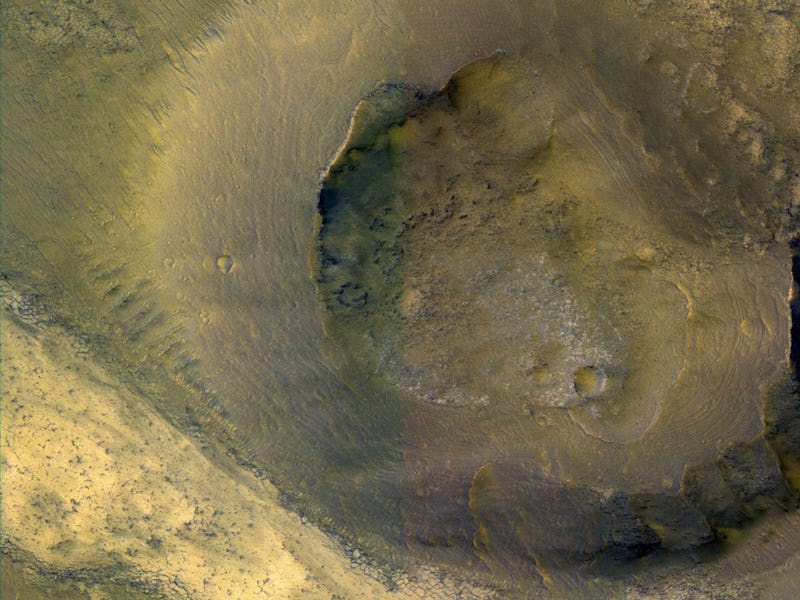Scientists solve a Mars mystery: The source of those lava-like flows
A new experiment recreated Martian conditions in a lab.

Satellite images of Mars have revealed thousands of channels that extend for hundreds of miles, and resemble lava flows similar to those seen on Earth.
Scientists observing these images have long believed that the channels formed in the aftermath of volcanic eruptions on the Red Planet, but have never been able to prove their origin.
However, a new study suggests that instead of burning hot lava, these land features were actually formed from something else entirely.
Scientists think the features were created from Martian mud. The study, published Monday in the journal Nature Geoscience, is based on an unusual experiment that shows how mud behaves differently on Mars than it does on Earth.
A new study suggests that these are mud volcanos on the surface of Mars.
Mars' Northern Hemisphere is dotted with mountain cones, which are covered by what appears to be a small crater on the top. However, that area has never been visited by NASA's lineage of Mars rovers, and so their formation remained a mystery to scientists observing Mars from afar.
In order to test whether these land formations were created from magma or mud, the researchers conducted an experiment to observe how mud would behave on Mars.
Here's how they did it — The purpose of the experiment was to recreate the environmental conditions of Mars within a lab. The team set up a low-pressure chamber that is 90 centimeters in diameter and 1.8 meters long with the planet's atmospheric pressure, composition and low surface temperatures.
Another chamber was set up with the regular conditions of Earth.
The team of researchers poured mud into both chambers, and observed the difference in the behavior of the mud.
As it turns out, mud behaves rather differently on Mars.
"Under the low atmospheric pressure of Mars, the mud flows behave in much the same way as 'pāhoehoe', or 'ropy', lava, which is familiar from large volcanoes on Hawaii and Iceland," Petr Brož, a researcher at the Czech Academy of Sciences, and lead author of the new study, said in a statement. "Our experiments show that even a process as apparently simple as the flow of mud – something that many of us have experienced for ourselves since we were children – would be very different on Mars."
Mud on Earth vs. Mud on Mars — In the Earth conditions, mud remains in somewhat liquid form. However, on Mars, the mud is more clumpy and acts more like lava flowing from volcanos on Earth and other planets in the Solar System. As mud spills out onto the Martian surface, it is able to flow for some time before it solidifies because of the low temperatures. However, it forms a shape that is different from the shape it would form on Earth.
The reason behind this change in behavior is due to Mars' low atmospheric pressure, which is 150 times lower than the pressure at sea level on Earth. Previous studies have shown the effect of this low pressure on liquid water, which boils and evaporates on Mars. However, these effects have never been tested on mud before this experiment.
The research may also help scientists in observing these flow features on the surface of other planets, and whether they formed from lava or mud.
Abstract: Large outflow channels on ancient terrains of Mars have been interpreted as the products of catastrophic flood events. The rapid burial of water-rich sediments after such flooding could have led to sedimentary volcanism, in which mixtures of sediment and water (mud) erupt to the surface. Tens of thousands of volcano-like landforms populate the northern lowlands and other local sedimentary depocentres on Mars. However, it is difficult to determine whether the edifices are related to igneous or mud extrusions, partly because the behaviour of extruded mud under Martian surface conditions is poorly constrained. Here we investigate the mechanisms of mud propagation on Mars using experiments performed inside a low-pressure chamber at cold temperatures. We found that low viscosity mud under Martian conditions propagates differently from that on Earth, because of a rapid freezing and the formation of an icy crust. Instead, the experimental mud flows propagate like terrestrial pahoehoe lava flows, with liquid mud spilling from ruptures in the frozen crust, and then refreezing to form a new flow lobe. We suggest that mud volcanism can explain the formation of some lava-like flow morphologies on Mars, and that similar processes may apply to cryovolcanic extrusions on icy bodies in the Solar System.
This article was originally published on